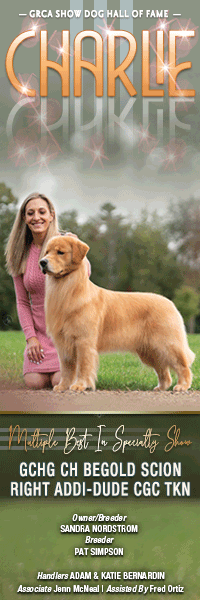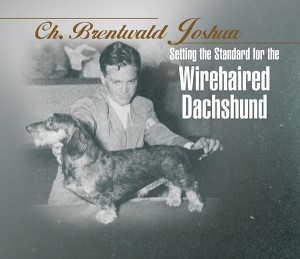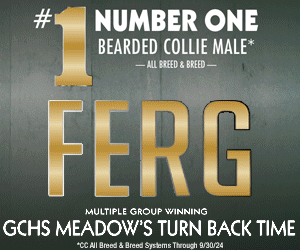Ch. Brentwald Joshua – Setting the Standard for the Wirehaired Dachshund
Click here to read the complete article
338 – The Annual, 2019-20
Conventional wisdom tells us that purebred design is a labor of love…an extremely long, arduous one. And, mainly, that’s correct. Technology has certainly streamlined the process, but it hasn’t devised any surefire shortcuts. For the record, wishful thinking, although enduringly popular, remains a no-go.
So let’s get to the startling exception that prompted this story. Every breed has its milestone dogs. They pop out of nowhere and, voilà, type instantly evolves about ten generations overnight. That breathtaking genetic transformation was way overdue for the Wirehaired Dachshund when Am. Mex. Can. Ch. Brentwald Joshua W. jumped the timeline and transported his breed to the cutting edge of purple and gold glory.
Smooths had long ago carved out their niche in America’s dog game. In 1924 AKC registered 43 Dachshunds. A decade later annual registrations exceeded 1,200–a 3,000 percent increase. By the ‘50s, when the dog show biz caught a headwind, their domination of the game was uncontestable.
It’s important to note that 90 percent of that phenomenal activity- as it had for the previous century -focused almost exclusively on Smooths. By luck or fate, it was the standard Smooth that nineteenth-century trendsetters crowned as the breed’s ideal. Their preeminence created a less than welcoming attitude towards the others. Explain-ing the late start of Longhairs in Britain, Fitch Daglish remarked in his 1937 book, “It seems strange that this very handsome variety should have remained practically unknown in Britain through all the prewar years during which Smooths enjoyed so much popularity.” By 1923 Dachshunds ruled in England, reliably drawing huge entries at Crufts. The standard at that time didn’t mention multiple varieties, therefore, “In those days there were no separate classes or breed registers for the different varieties. Thanks to lack of foresight, classes were open to all Teckels, which theoretically included Ratzmann vom Habichtshof.”
The first Longhair in Britain was imported, processed through quarantine, and set to launch for Crufts that year. Historians agree that he was superb, which isn’t the point. He was eligible and shown. “The judge awarded the lone Longhair first, and gave him the CC over all the Smooths….the decision created something of a sensation…but rather than helping to win favor for this novel variety exhibitors of Smooths did not take their defeat well.” That’s an understatement. Beating over 100 Smooths nearly triggered a riot. Alarmed fanciers feared that Longhairs would now overtake the breed, thus obliterating the entire Smooth gene pool. That was an overreaction considering that Britain’s Longhair population then consisted of two dogs. But, for several years, Longhairs remained relegated to the British equivalent of Miscellaneous, which somewhat curbed interest in cultivating other varieties.
Click here to read the complete article
338 – The Annual, 2019-20
Short URL: https://caninechronicle.com/?p=176378
Comments are closed












